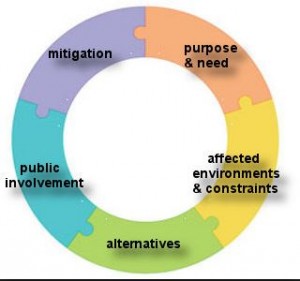 The National Environmental Policy Act (NEPA) requires Federal agencies to consider the environmental effects of their proposed actions before beginning a project and to examine the alternative actions that would reduce or eliminate potential threat or harm posed to the environment. Through NEPA, the environmental impacts of proposed actions must be made available to the public as well as to other Federal, State, and local agencies. While NEPA does not require that the proposed action or activity be free of environmental impacts, it requires that the Federal agency considers environmental impacts, alternatives and mitigation as factors in the decision to implement an action, project, or program.
The National Environmental Policy Act (NEPA) requires Federal agencies to consider the environmental effects of their proposed actions before beginning a project and to examine the alternative actions that would reduce or eliminate potential threat or harm posed to the environment. Through NEPA, the environmental impacts of proposed actions must be made available to the public as well as to other Federal, State, and local agencies. While NEPA does not require that the proposed action or activity be free of environmental impacts, it requires that the Federal agency considers environmental impacts, alternatives and mitigation as factors in the decision to implement an action, project, or program.
LaRC’s NEPA Program is managed by environmental staff located within the Center Operations Directorate and the LaRC NEPA Manager who oversees its implementation at the Center. LaRC’s NEPA program ensures that the Center is proactive in meeting its Federal stewardship responsibilities while ensuring mission success and lowering environmental liability. Early implementation of NEPA in the planning stages of LaRC’s programs and projects can be critical to lowering the risk to mission schedules and costs, as well as risks to the environment.
The first step in LaRC’s environmental review process is for program and projects managers to submit an Environmental Project Planning form to the LaRC NEPA Manager. The form requires a detailed description of the program or project and includes a series of questions spanning various environmental media areas. The form is utilized by the LaRC NEPA Manager and environmental staff to perform an environmental impact anaylsis and to determine the appropriate environmental requirements (e.g., permitting, waste disposal), as well as the level of documentation required to comply with NEPA.
There are three levels of review and documentation that are integral parts of the overall NEPA process:
- Categorical Exclusion (CatEx) – documents proposed actions that NASA has designated as normally having no significant impacts on the human environment. A Record of Environmental Consideration (REC) may be used to document that a CatEx applies to a proposed action.
- Environmental Assessment (EA) – documents any proposed actions that could possibly have a significant impact on the human environment. In the event that an EA is prepared and there are no significant impacts identified, or the impacts can be mitigated, then the decision is documented as a Finding of No Significant Impact (FONSI). If there would be significant impacts, then NASA would prepare a Notice of Intent (NOI), and scoping would be conducted to prepare an Environmental Impact Statement (EIS).
- Environmental Impact Statement (EIS) –documents proposed actions expected to have a significant impact on the quality of the human environment. The EIS would describe the proposed action, any alternative actions that were identified, and the environmental impacts associated with the alternative actions. The decision on which action would be implemented is documented in a Record of Decision (ROD).
NASA LaRC’s NEPA Library:
Recent Environmental Assessments –
- Finding of No Significant Impact (FONSI) for the Supplemental Environmental Assessment for the NASA Langley Master Plan, August 2017
- Final Supplemental Environmental Assessment for the NASA Langley Research Center Master Plan, August 2017
Past Environmental Assessments –
- Finding of No Significant Impact (FONSI) for the NASA Langley Research Center Master Plan, August 2013
- Final Environmental Assessment for the NASA Langley Research Center Master Plan, June 2013
LaRC’s Master Planning Links (Internal Only)
Additional Resources:
NASA Headquarters has developed a public NASA NEPA website that has additional information and resources about the NEPA process, NASA’s procedures for complying with NEPA, and NASA’s NEPA library which includes public access to agency-wide environmental assessments and environmental impact statements: https://www.nasa.gov/emd/nepa
Note: This page links to PDF files. Use this link to download Adobe Reader if needed.

